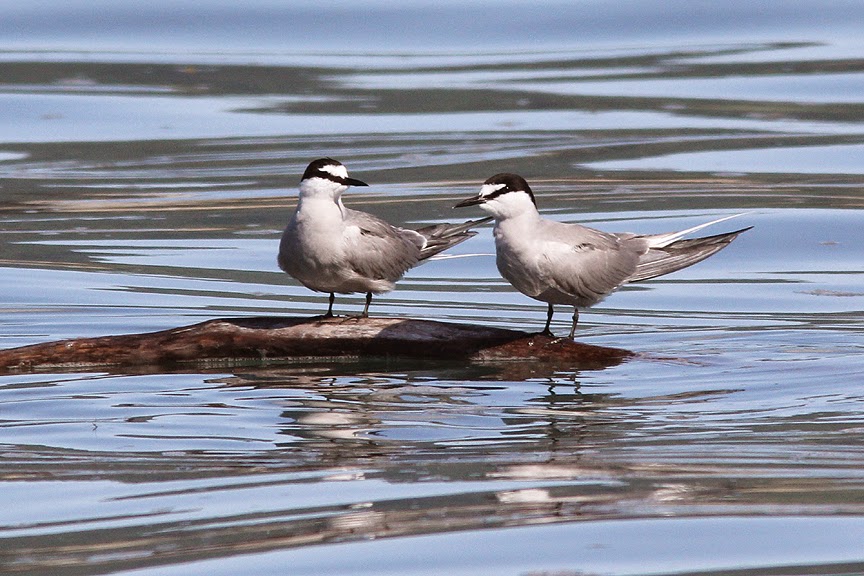Day five of our ten day birding tour of Alaska was a very full day, to say the least. We started the day at 7 am with a quick breakfast, then drove the spectacular Sterling Highway along Cook Inlet from Soldotna to Homer, where we were treated to amazing views of five volcanoes. Then three-plus hours on a boat in Kachemak Bay where we saw a stunning array of pelagic birds and, of course, sea otters.
We left Homer around 3:30 pm and drove back north along the Sterling Highway. There's no direct way to get from Homer to Seward as there are three large lakes and this little thing known as the Harding Ice Shield between the two. Then again, in Alaska, this is about as direct as it gets.
 |
| The route from Homer to Seward, mostly on Sterling Highway. |
We stopped again at Anchor Point for a late lunch. The tide was out but there were still very few Bald Eagles on the flats. Fishermen use the launch here and often leave gut piles from their fish on the beach, but apparently the pickings were slim this day.
 |
| Some of our group getting ready to pose in front of the sign. |
I took five minutes to just lay in the grass at the picnic area, soaking up the sun and relaxing, and to admire once more the view of Mt. Redoubt. I had never seen anything like it.
 |
| Mt. Redoubt revisited, because why not? Simply stunning. |
I don't recall there being many songbirds around, but there were a number of crows. I didn't think right away to get pics until I realized this was a new bird for me. Duh!
 |
| Northwest Crow at Anchor Point. |
The rest of the drive to Seward seemed to take forever. We got caught up in traffic as there was some construction on the two-lane highway. While we waited we rolled the windows down and someone heard a Townsand's Warbler on the side of the road. Bill wouldn't let us get out and I couldn't see it from where I was sitting, so I couldn't count it for the day.
We finally arrived in Seward around 7:30-8:00 pm. We checked into the Holiday Inn Express, then walked over to Chinooks for dinner. What an amazing view of the marina and the mountains beyond Resurrection Bay.
 |
| Evening in Seward, overlooking the marina. |
After dinner about half of our group climbed back in the van to do a little late evening birding. There is a woman north of town who puts out many feeders and brings some interesting birds in, like the Rufus Hummingbird. On the way we stopped at a marshy area to look for waterfowl. The lush greens and dark spruce with the snow-tipped mountains and blue sky were painfully beautiful. We got out for a little while to enjoy the serenity of the place.
 |
| North of Seward. |
We didn't see much here, just a pair of Ring-necked Ducks and a pair of Trumpeter Swans. Mama was on the nest but dad was a bit closer to the road, preening and stretching.
 |
| Trumpeter Swans have amazingly large feet. |
There wasn't much to see at the feeders. We didn't get out of the van--who wants a group of gawking birders in your front yard?--but we did see a couple female Pine Grosbeaks, among some other more common (for us) birds like Downy Woodpeckers. But on the way back we stopped on the side of the road near some spruce and managed to entice a Varied Thrush to come for a visit. It's a lousy photo but it was a first, so....
 |
| Varied Thrush. |
In all I saw 30 birds on day five, 15 which were new to me:
Black-capped chickadee
American Robin
Varied Thrush*
Yellow-rumped warbler
Pine Grosbeak
Pine Siskin
Downy Woodpecker
Hairy Woodpecker
Violet-green swallow*
Trumpeter Swan
Ring-necked Duck
Common Raven
Northwestern Crow*
Double-crested Cormorant
Pelagic Cormorant*
Surf Scoter*
Barrow's Goldeneye*
Bald Eagle
Spotted Sandpiper
Herring Gull
Glaucous-singed Gull*
Black-legged Kittiwake*
Aleutian Tern*
Common Murre*
Pigeon Guillemot*
Horned Puffin*
Tufted Puffin*
White-winged Scoter*
Marbled Murrelet*
Harlequin Duck
Next: Day six, and an all-day boat trip on Resurrection Bay!!

















































